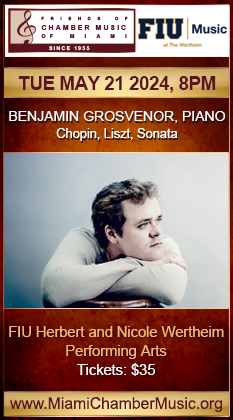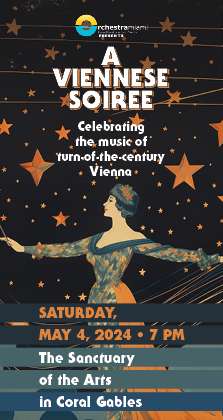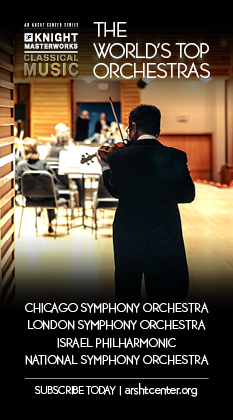Miami City Ballet opens 25th season in celebratory style

Renato Penteado and Jeanette Delgado in "Theme and Variations" presented Friday night by Miami City Ballet. Photo: Kyle Froman.
The twenty-fifth anniversary season of Miami City Ballet opened Friday night at the Arsht Center with a gala program of three contrasted ballets by two of the twentieth century’s master choreographer –Jerome Robbins and George Balanchine. Showcasing some stunning principal dancers and a high-precision corps in top form, the challenging program marked the return of live orchestral music (after a season of dancing to recorded soundtracks) and the debut of a gifted conductor.
Robbins’ balletic output can be divided into his austere, classically based settings of musical masterworks (Dances at a Gathering to Chopin piano scores, Prokofiev Violin Concerto, Goldberg Variations, Afternoon of a Faun) and brash, flashy, entertainment pieces that echo his Broadway legacy (Fancy Free, I’m Old Fashioned, Gershwin Concerto).
Robbins’ 1953 Fanfare, a setting of Benjamin Britten’s Young Person’s Guide to the Orchestra, weaves those two strands together with the dazzling ingenuity that marked Robbins’ five decade career in classical dance, theater and cinema.
A beguiling array of multi-colored costumes designed by Broadway and Hollywood legend Irene Sharaff lit up the stage Friday night. With artistic director Edward Villella as the Major Domo and narrator (in appropriately ornate attire), the dancers portrayed the instruments and choirs of the orchestra. Amanda Weingarten’s supple extensions and grace epitomized Robbins’ poetic depiction of the oboe. Patricia Delgado and Didier Bramaz danced a sensual pas de deux to the dark tones of the violas. Bedecked in white, Jennifer Carlynn Kronenberg was the prima ballerina con brio, her astounding leaps to harp glissandos illuminating Robbins’ reinvention of classical dance. Britten’s quirky writing for the double basses found vivid expression in the rapid agility of Yang Zou’s heart-stopping jumps.
To the spooky sounds of the bassoon, Stephen Satterfield and Marc Spielberger were vaudevillians, colliding with each other in jest while dancing on pointe at top speed. The comedic percussion trio of Isanusi Garcia-Rodriguez, Renato Penteado and Carlos Miguel Guerra brought showbiz pizzazz to their acrobatic antics. The stage was ablaze in color for the finale as the entire cast danced up a storm in true Radio City Music Hall fashion, a stellar conclusion to Robbins’ artfully conceived divertissement.
Along with the solemn Russian religious ceremony of his late setting of the final movement of Tchaikovsky’s Pathetique Symphony, Bugaku is Balanchine’s most atypical ballet. Eschewing his trademark neo-classicism, Balanchine created an ancient Japanese ritual marriage ceremony in this stylized 1963 work, greatly influenced by traditional kabuki theater. The heart of this unique piece is the central pas de deux, at once erotic and violent. The athleticism of the male dancers, particularly the protagonist, contrasts sharply with the delicacy of movement for the women. In the concluding wedding sequence, Karinska’s flowing costumes become part of the choreographic spectacle. Toshiro Mayuzumi’s original score is a Japanese Daphnis and Chloe, rising to sensuous climaxes of lush string and brass sonorities.
Haiyan Wu and Garcia-Rodriguez were the stunning protagonists. Wu’s straight upward leg extension above her head was astonishing. The duo’s mating dance registered fear, brutality and romance in movement both austere and boldly athletic, ably abetted by the pitch perfect timing and finely etched delicacy of the four member female corps.
Balanchine’s 1947 setting of Tchaikovsky’s Theme and Variations (from the Suite No. 3) is a tribute to balletic pioneer Marius Petipa and the imperial tradition of St. Petersburg’s Kirov Ballet. (The young Balanchine had been a member of that acclaimed company.) Utilizing the vocabulary of nineteenth-century classicism, Balanchine created a glorious series of variations, culminating in a grand duo and stately polonaise for the entire company.
The pinpoint precision of the female dancers in the fourth variation was the epitome of balletic elegance, Balanchine’s intricate patterns brought to life with disarming simplicity. Jeanette Delgado was light as air in her bouncy solo. Penteado’s fast leaps generated excitement in Balanchine’s male tour de force. The partnering of these superb dancers was especially subtle and refined in the pas de deux, a touch of heartbreak intruding on the surface beauty of movement.
In an evening of stellar performances, some of the best came from the orchestra pit as live music again resounded at the company’s performances. Gary Sheldon made an impressive debut as principal conductor. A veteran of the San Francisco Ballet, Sheldon deftly calibrated music and movement without sacrificing momentum or subtlety. His Britten was rousing and light hearted. Sheldon captured the cinematic vistas of Mayuzumi’s Asian pastiche and brought appropriate romantic grandeur and richness to Tchaikovsky’s glorious orchestral writing, drawing glistening sounds from a strong ensemble. Music and dance coalesced in celebratory fashion.
Miami City Ballet repeats the program 8 p.m. Saturday and 2 p.m. Sunday at the Arsht Center, November 12-14 at the Broward Center in Ft. Lauderdale and November 19-21 at the Kravis Center in West Palm Beach. 877-929-7010, miamicityballet.org.
Posted in Performances, Uncategorized
Leave a Comment
Sat Oct 16, 2010
at 3:08 pm
No Comments



